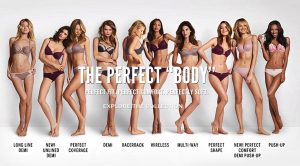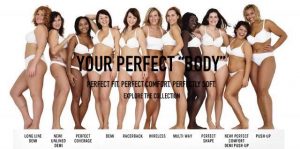
Victoria secret is one of the world’s largest lingerie retailer. With over 1,100 store location worldwide and thousands of online visits a day (victoriasecret.com, nd), Victoria secret has a significant amount of influence on women and the market. In the year of 2014, Victoria Secret released the “Body” collection featuring bras that supposedly fit every figure perfectly. This very controversial campaign was released in stores across the United Kingdom as well as on the Victoria Secret online site. The image displayed above was the feature of the campaign along with the phrase ‘The Perfect “Body”’.
It is undoubtful that the media has a substantial influence on the body image and self-esteem of women of all races, ages, and ethnicities. The media has now become a platform where individuals learn and develop attitudes about concepts within our society, including body image (Perloff, 2014). This influence has been, and continues, to grow along with the popularity of social media. According to Shields and Heinecken (2011), advertisements present the social attitudes, norms, and ideals of a society.
The Ad (shows above), featuring tall and extremely slim models posing with perfectly styles hair and smiles further enforces unrealistic expectations and aspirations of the “perfect”/ “ideal” body. While the Phrase ‘The Perfect “Body”’ raises questions of concern among women with bodies that do not look like the ones photographed above: “There’s no mistaking what they mean by ‘perfect’: perky of bosom, tiny of tummy and negligible of behind — with a thigh gap wide enough to park a bicycle in” (Vine, 2014, para. 8).
According to Choi, Leshner, and Choi (2008) body image is the multidimensional concept of an individual’s satisfaction with their own physical appearance, which is influenced both positively and negatively by the perceptions of others of ourselves. Research has shown that women are likely to compare themselves to other women featured in advertisement – this as a result has a negative influence on their body image and self-esteem (Choi, Leshner and Choi, 2008). Idealizing unrealistic body images, such as the one photographed above, leads to many issues in the confident, self-esteem, and self-worth of women (Choi, Leshner and Choi, 2008). Advertisement, especially when publicized by influential companies such as Victoria Secret, have tremendous influence on society and cause severe (negative) consequences when featuring unrealistic expectations of the body.

When developing my reconstructed advertisement, my goal was to create a similar image that would present women of all sizes, races, ethnicities, and ages. Opposite to the original “Body” campaign by Victoria Secret, the new and revised advertisement emphasizes the purpose of the product – which was to fit every body shape perfectly while displaying every body shape. The reconstructed advertisement I have created above was constructed with the purpose of empowering women’s bodies and encouraging self-love.
The image shown on the reconstructed Advertisement was derived from a different campaign (by Dove) in which empowered women to love their bodies and differences. The reason I chose to use this exact image for my advertisement was because, unlike the original ad, women of all sizes, shapes, races, and ethnicities are clearly represented in the above image. In this photograph, there is also a representation of realistic body shapes and ideals in which real women can relate to.
I chose to revise the original phrase ‘The Perfect “Body”’ to‘Your Perfect “Body”’ with the hopes of allowing women to recognize their body as individualized. Instead of encouraging women to look up to the unrealistic body ideals that are presented by the media, women should be encouraged to look up to realistic, healthy, and relatable ideals that would enhance their confidence and self-love. The revised phrase also relates back to the product Victoria Secret is trying to sell which is a bra that fits every body shape perfectly – your new perfect “Body”bra.
The purpose of the revised image, unlike the original advertisement for this campaign, was to boost the confident, self-esteem, and self-love of women by emphasizing their personal body differences and presenting realistic body ideals – there is no such thing as the “perfect” body. As previously mentioned, the media has a tremendous amount of influence women, especially now with the growing popularity of social media, thus the need to create advertisement with positive influences on body ideal (of both women and men) is detrimental to the development and well-being of individuals around the world.
References:
Careers. (n.d.). Retrieved from https://www.victoriassecret.com/careers.
Choi, Y. “., Leshner, G., & Choi, J. (2008). Third-person effects of idealized body image in magazine advertisements. American Behavioral Scientist, 52(2), 147-164. doi:10.1177/0002764208321348
Perloff, R. (2014). Social media effects on young women’s body image concerns: Theoretical perspectives and an agenda for research. Sex Roles, 71(11-12), 363-377. doi:10.1007/s11199-014-0384-6
Peterson, H. (2014, October 31). Victoria’s Secret Sparks Outrage With ‘Perfect Body’ Campaign. Retrieved from https://www.businessinsider.com/victorias-secret-perfect-body-campaign-2014-10.
Robertson, K. (2013, April 29). Come on Dove, women don’t need to find their ‘beauty spots’. Retrieved from https://www.telegraph.co.uk/women/womens-life/10025622/Come-on-Dove-women-dont-need-to-find-their-beauty-spots.html.
Shields, V. R., Heinecken, D., & Project Muse University Press eBooks. (2002;2001;). Measuring up: How advertising affects self-image. Philadelphia: University of Pennsylvania Press.
Vine, S. (2014, October 30). Why I don’t want my daughter to see Victoria’s Secret advert, writes SARAH VINE. Retrieved from https://www.dailymail.co.uk/debate/article-2815015/Offensive-cruel-irresponsible-don-t-want-daughter-advert-writes-SARAH-VINE.html.